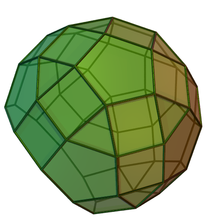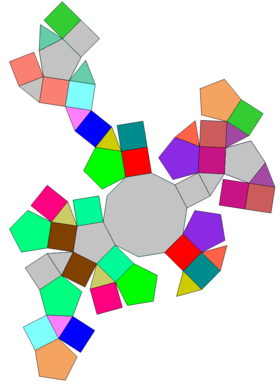
In geometry, a Johnson solid is a strictly convex polyhedron each face of which is a regular polygon. There is no requirement that each face must be the same polygon, or that the same polygons join around each vertex. An example of a Johnson solid is the square-based pyramid with equilateral sides ; it has 1 square face and 4 triangular faces. Some authors require that the solid not be uniform before they refer to it as a “Johnson solid”.
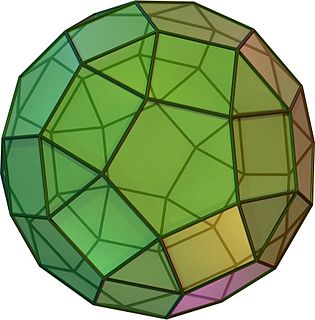
In geometry, the rhombicosidodecahedron is an Archimedean solid, one of thirteen convex isogonal nonprismatic solids constructed of two or more types of regular polygon faces.

In geometry, the elongated square gyrobicupola or pseudo-rhombicuboctahedron is one of the Johnson solids. It is not usually considered to be an Archimedean solid, even though its faces consist of regular polygons that meet in the same pattern at each of its vertices, because unlike the 13 Archimedean solids, it lacks a set of global symmetries that map every vertex to every other vertex. It strongly resembles, but should not be mistaken for, the small rhombicuboctahedron, which is an Archimedean solid. It is also a canonical polyhedron.

In geometry, the pentagonal cupola is one of the Johnson solids. It can be obtained as a slice of the rhombicosidodecahedron. The pentagonal cupola consists of 5 equilateral triangles, 5 squares, 1 pentagon, and 1 decagon.

In geometry, the diminished rhombicosidodecahedron is one of the Johnson solids. It can be constructed as a rhombicosidodecahedron with one pentagonal cupola removed.

In geometry, the gyrate rhombicosidodecahedron is one of the Johnson solids. It is also a canonical polyhedron.

In geometry, the parabidiminished rhombicosidodecahedron is one of the Johnson solids. It is also a canonical polyhedron.

In geometry, the metabidiminished rhombicosidodecahedron is one of the Johnson solids.

In geometry, the tridiminished rhombicosidodecahedron is one of the Johnson solids. It can be constructed as a rhombicosidodecahedron with three pentagonal cupolae removed.

In geometry, the trigyrate rhombicosidodecahedron is one of the Johnson solids. It contains 20 triangles, 30 squares and 12 pentagons. It is also a canonical polyhedron.
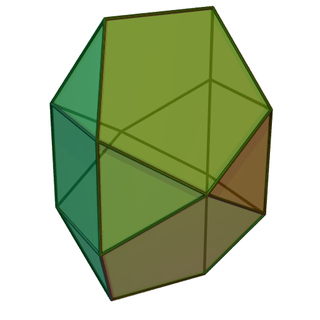
In geometry, the bilunabirotunda is one of the Johnson solids. A Johnson solid is one of 92 strictly convex polyhedra that is composed of regular polygon faces but are not uniform polyhedra. They were named by Norman Johnson, who first listed these polyhedra in 1966.

In geometry, the pentagonal orthobicupola is one of the Johnson solids. As the name suggests, it can be constructed by joining two pentagonal cupolae along their decagonal bases, matching like faces. A 36-degree rotation of one cupola before the joining yields a pentagonal gyrobicupola.

In geometry, the pentagonal gyrobicupola is one of the Johnson solids. Like the pentagonal orthobicupola, it can be obtained by joining two pentagonal cupolae along their bases. The difference is that in this solid, the two halves are rotated 36 degrees with respect to one another.

In geometry, the elongated pentagonal orthobicupola or cantellated pentagonal prism is one of the Johnson solids. As the name suggests, it can be constructed by elongating a pentagonal orthobicupola by inserting a decagonal prism between its two congruent halves. Rotating one of the cupolae through 36 degrees before inserting the prism yields an elongated pentagonal gyrobicupola.

In geometry, the parabigyrate rhombicosidodecahedron is one of the Johnson solids. It can be constructed as a rhombicosidodecahedron with two opposing pentagonal cupolae rotated through 36 degrees. It is also a canonical polyhedron.

In geometry, the paragyrate diminished rhombicosidodecahedron is one of the Johnson solids. It can be constructed as a rhombicosidodecahedron with one pentagonal cupola rotated through 36 degrees, and the opposing pentagonal cupola removed.
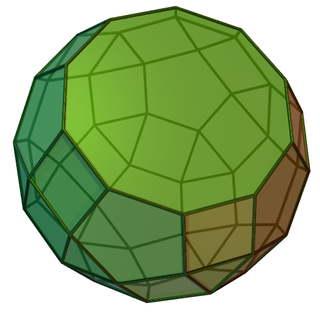
In geometry, the metagyrate diminished rhombicosidodecahedron is one of the Johnson solids. It can be constructed as a rhombicosidodecahedron with one pentagonal cupola rotated through 36 degrees, and a non-opposing pentagonal cupola removed.
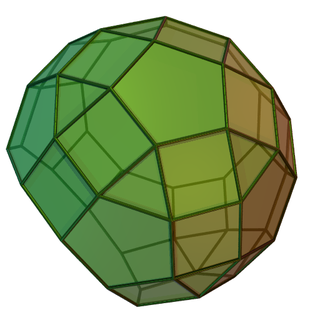
In geometry, the gyrate bidiminished rhombicosidodecahedron is one of the Johnson solids.
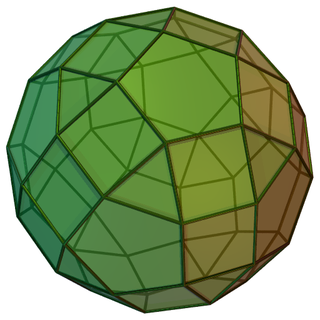
In geometry, the metabigyrate rhombicosidodecahedron is one of the Johnson solids. It can be constructed as a rhombicosidodecahedron with two non-opposing pentagonal cupolae rotated through 36 degrees. It is also a canonical polyhedron.
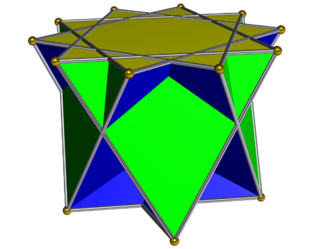
In geometry, the crossed pentagrammic cupola is one of the nonconvex Johnson solid isomorphs, being topologically identical to the convex pentagonal cupola. It can be obtained as a slice of the great rhombicosidodecahedron or quasirhombicosidodecahedron. As in all cupolae, the base polygon has twice as many edges and vertices as the top; in this case the base polygon is a decagram.
